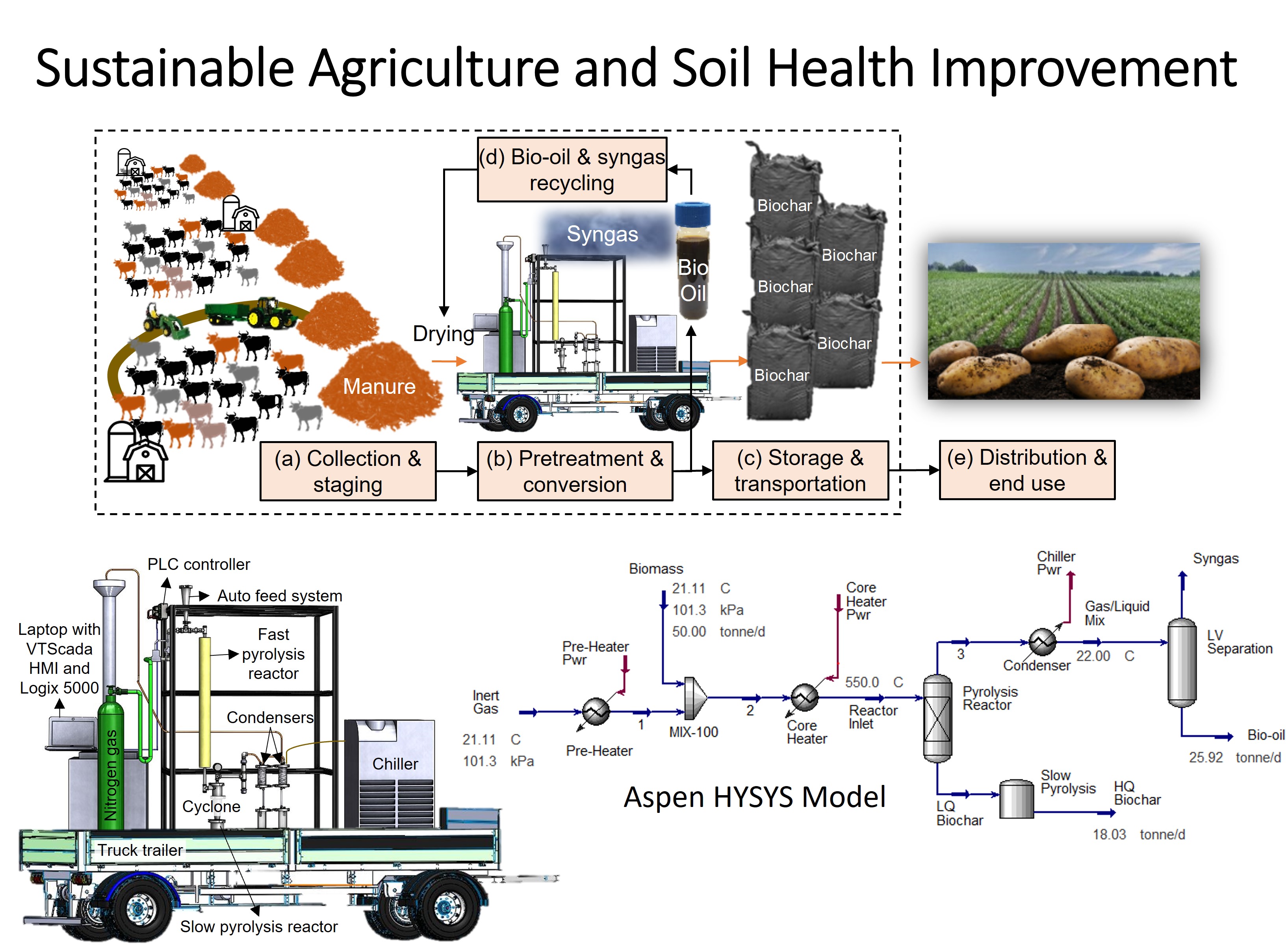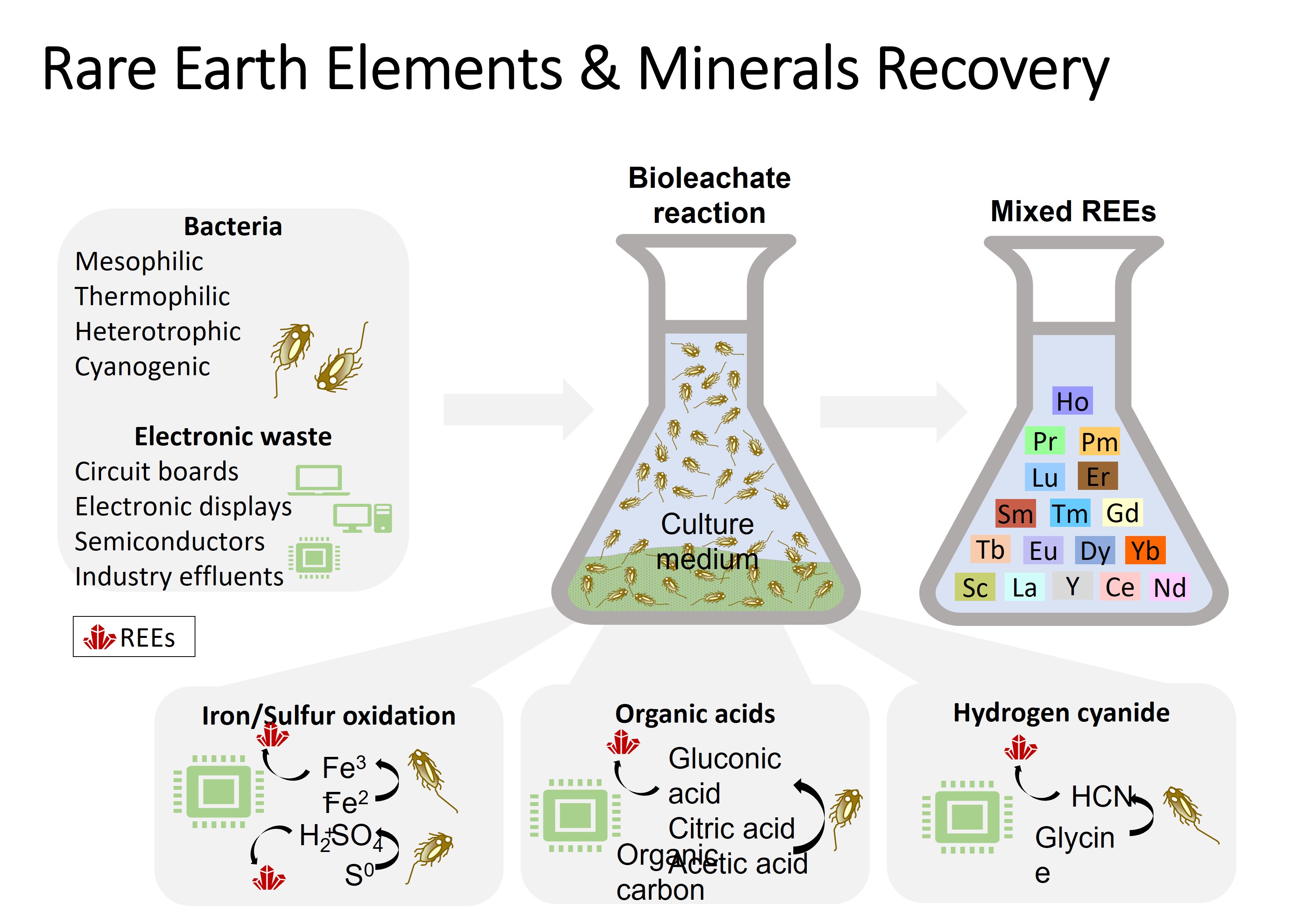The Renewable and Sustainable Manufacturing Lab (RSML) aims to maintain many research opportunities that can positively impact all segments of food-energy-water systems (FEWS). In brief, we have been working and planning to undertake more innovative research in the following Research Thrusts:
Thrust 1. Chemical and biochemical compounds production from biomass feedstocks or urban wastes
The overarching goal of this multi-disciplinary Thrust is to advance the existing conversion processes for engineered materials and renewable materials production (e.g., hydrocarbon fuel and engineered biochar) from various waste streams (e.g., biomass feedstocks, plastics wastes, e-wastes, and animal manure) through integrating the new mechanical inventions with growing cyber-based control and optimization initiatives. For example, biofuel conversion process represents the most substantial portion of the total biofuel cost (over 60%) based on recent techno-economic studies. Further investigation is needed not only in empirical work for specific applications, but for the creation of conceptual cyber-infrastructures to advance the operations and increase the technical growth. To accomplish the goal of this Thrust, we are pursuing two research tasks: (a) modernizing the physical-based interface of the waste conversion process, using programmable logic controllers, and developing new upgrading technologies (e.g., physicochemical pathways), and (b) constructing an adaptive cyber-based platform for data-driven decision making, including intelligent control and optimization modules.
Thrust 2. Precision agriculture, soil-plant health improvement, and food processing
According to the U.S. Department of Agriculture (USDA), Idaho ranks in the top ten in the nation in nearly 30 of 168 agriculture commodities. The state ranks number one in the nation in the production of potatoes (34%) and Austrian winter peas. Idaho grows 70% of the hybrid temperate sweet corn seed produced in the world. For alfalfa, hay, hops, mint, and sugar beets, Idaho is number two in production for the nation. For fresh prunes and plums, Idaho is number three in production for the nation. Idaho ranks 1st in the nation for production of food sized trout with 46%. Therefore, technology breakthroughs are essential for addressing agricultural challenges, e.g., crop quality and productivity. The main goal of this Thrust is to promote Idaho crop production sustainability through the use of renewable materials, slow-release fertilizers, and soil conditioners, as well as advanced cyber-based systems (e.g., data analytics and communication systems), and intelligent mechanical inventions (e.g., remote sensors) for fertigation (injection of chemicals into an irrigation system), which is one of the major cost-drivers in farming. Integrated analysis of agricultural and soil ecosystems is growing with improvements in technologies, standards, and data-driven decision making. To accomplish the goal of this Thrust, we aim to develop renewable products and sustainable technologies, as well as construct and empirically verify a self-adaptive cyber-physical system for real-time sensing, control, and optimization of water-fertilizer use efficiency and soil-plant health improvement, using slow-release fertilizers and soil conditioners.
Thrust 3. Sustainable aquaculture and water treatment
Idaho’s aquaculture industry ranks as the 3rd largest food-animal industry in the state and is the nation’s largest commercial producer of rainbow trout. Also, Idaho ranks 3rd in the nation for milk production. Annual produced waste (both solid and liquid pollutants) from the food-animal and aquaculture industry has negative impacts on surface water and groundwater that can pose eutrophication and other environmental problems. For example, the wastewater discharged from fish hatcheries can contain uneaten fish food, fish feces, nutrients (especially phosphorus), algae, parasites and pathogens, drugs, and other chemicals. The overarching aim of this Thrust is to promote Idaho fish production sustainability through the use of renewable materials, such as carbonized biomass or engineered biochar, and bridge the gap between knowledge discovery and technology (e.g., new tools and machines) implementation in manufacturing and improve the performance of the growing aquaculture sector, by meeting often-conflicting sustainability objectives (e.g., economic, environmental, and social) through different sustainability approaches (e.g., life cycle assessment, energy monitoring and analysis, process energy optimization strategies, and social assessment methods). To accomplish the goal of this Thrust and address sustainability challenges in Idaho, we aim to conduct life cycle assessment (LCA) and input-output analysis to find the major pollution sources and find practical solutions to reduce the environmental emissions, such as blended wood-based biochar that has application in water-nutrient recycling at fish farms.
Thrust 4. Rare earth elements exploration and recovery from electronic wastes and ore in Idaho
According to the U.S. Geological Survey (USGS) and Idaho Geological Survey (IGS), Idaho is ranked as one of the most favorable mining jurisdictions that has compiled a national inventory of critical mineral resources, with two of the most promising prospects. The overarching goals of this Thrust are to expand Idaho-sourced REEs research and development in central Idaho and identify, coordinate, and develop research expertise. To accomplish the goal of this Thrust, we aim to (a) identify the areas that have enhanced concentrations of REEs in collaboration with IGS and our industry partner, Idaho Strategic Resources (IDR), (b) develop processing and extraction practices for mixed rare earth oxide (REO) production in collaboration with INL and CMI, and (c) conduct techno-economic analysis (TEA) and environmental impacts assessment or LCA for both upstream and midstream segments. Our current collaboration with IGS and IDR is beneficial to UI to contribute to REEs exploration projects (Diamond Creek and Roberts) and planned initial mapping, sampling, and drilling 10-20 holes over the next 12 months. IDR’s vision is to expand Idaho-sourced REEs exploration in central Idaho and address national priorities, such as reducing U.S. reliance on foreign suppliers and promoting domestic job creation. IDR partnership with my research group, along with support from Idaho IGEM-Commerce, would provide critical support, enable the commercialization of IDR’s current products, and help establish additional intellectual property (IP) on new material configurations and product lines.
Sponsors and Collaborators
- Idaho Global Entrepreneurial Mission (IGEM)-Commerce
- Aquaculture Research Institute (ARI)
- Idaho Water Resources Research Institute (IWRRI)
- Idaho Geological Survey (IGS)
- United States Geological Survey (USGS)
- University of Idaho Office of Research and Economic Development (ORED)
- Center for Advanced Energy Studies (CAES)
- National High Magnetic Field Laboratory (MagLab)
- Idaho National Laboratory (INL)
- College of Eastern Idaho (CEI)
- National Science Foundation (NSF)
- Idaho Strategic Resources (IDR)
- Riverence Provisions LLC






















